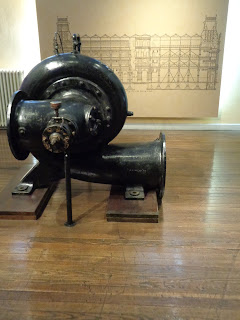Inspired by Bernini's
Four Rivers Fountain, one of the main attractions on my
city highlights walking tour in Rome, I've always longed to visit the Rio della Plata. Bernini's depiction of South America's great river features a river god covered in silver coins aside what is suppose to be an armadillo but appears to be more like a sea dragon. Nevertheless, the river and all its immigration history and as the birthplace of the exotic tango was one of the first places I wanted to visit in Buenos Aires.
However, it is nowhere to be found in Buenos Aires. While it is in the hearts of all the
portenos, it is not in the heart of the city. There is only one park from where the river is visible, the
Reserva Ecologica Costanera Sur, a true paradise for nature lovers with over 200 different species of birds and a nice bike path (and no armadillos). We failed several attempts to see this park. The first time it was closed for political strikes the day before the presidential election. The second time it was closed because it had rained the day prior. And finally, the third attempt was its weekly day of closure, Monday.
At the turn of the 20th century the river welcomed 4 million immigrants, 2 million of which were from Italy. One of whom was my grandfather who later settled in New York. Another one of these immigrant's was a distant relative of my husband who we had the pleasure of meeting and who provided us with the great fortune of finding the Rio della Plata. This required traveling outside the city for a much needed breath of fresh air; because despite its name Buenos Aires does not have a lot of
buen aria.
At the
Paseo de la Costa de Vicente Lopez I discovered the Rio della Plata is hardly a river. With a width of about 140 miles, many geographers consider it a marginal sea. Secondly, it is hardly silver. It's minerals reflect a marshy brown color, making Rome's "yellow" Tiber seem like crystal.
 |
| View of Rio della Plata from Paseo della Costa Vicente Lopez |
While I was disappointed the river was inapproiately named, the riverfront showcased a work of art that became very personal to me. Our distant relative was a sculptor and his masterpieces we found in several parks on both the Rio della Plata and Rio Parana. These works of art, not the river itself, were the true testimony. They were the true reflections of the ideas and creativity from abroad that made Buenos Aires and its European flair.
 |
| Statue of navigator Vito Dumas by local artist Adriano Berna |
 |
| Statue by Adriano Berna dedicated to rowers, in front of a rowing club on the Rio Parana in Tigre |
If you are in Buenos Aires, it is worth of trip to Tigre, approximately an hour by train. If not to see Adriano Berna's masterpieces, then to explore the city's bustling daily market.
For a deeper understanding of Buenos Aires' immigration history, visit the
Immigration Museum located near Puerto Madero. The museum was converted from a hotel that housed 40 percent of the immigrants upon arrival. The museum and its records are in informative, but it is the venue itself that is most evocative. The lodge held 4,000 people at a time for a period of 5 days as each immigrant was provided their first roof and meal awaiting passage into a new life.













